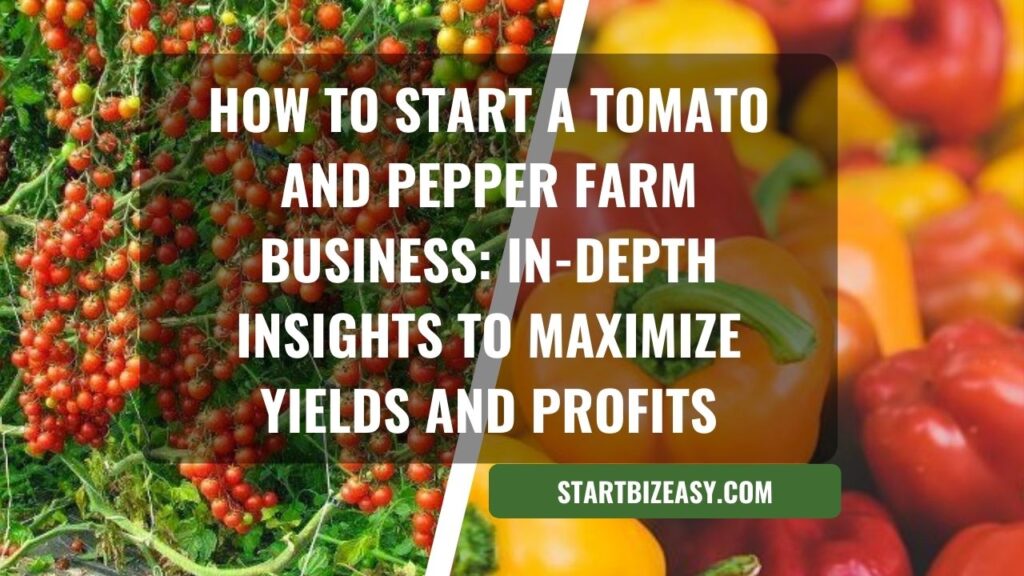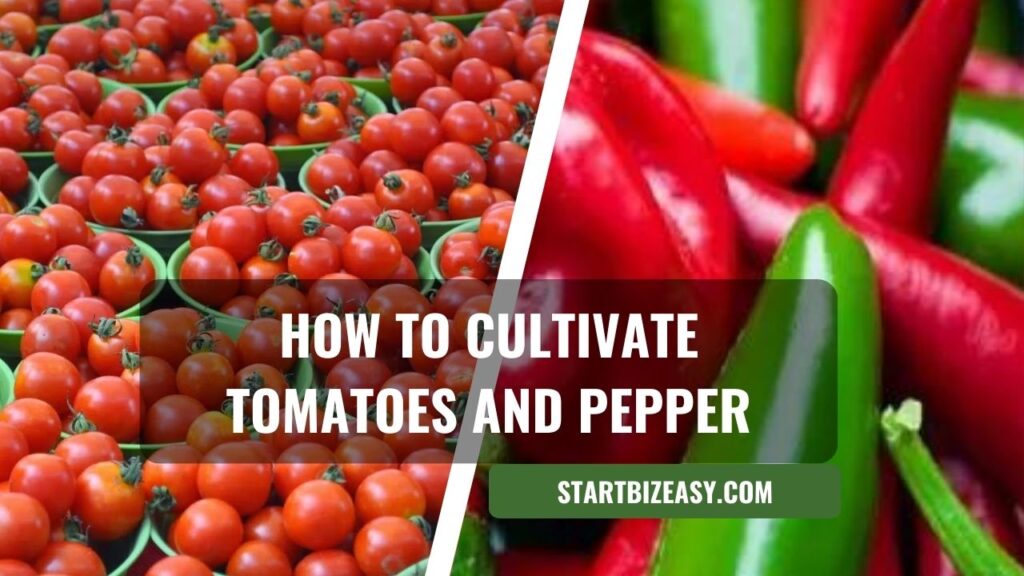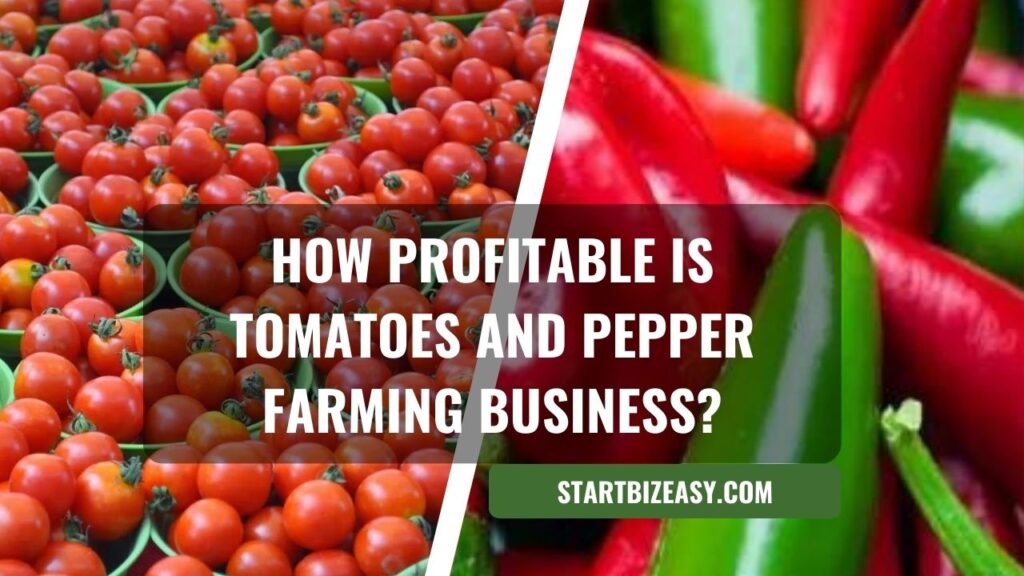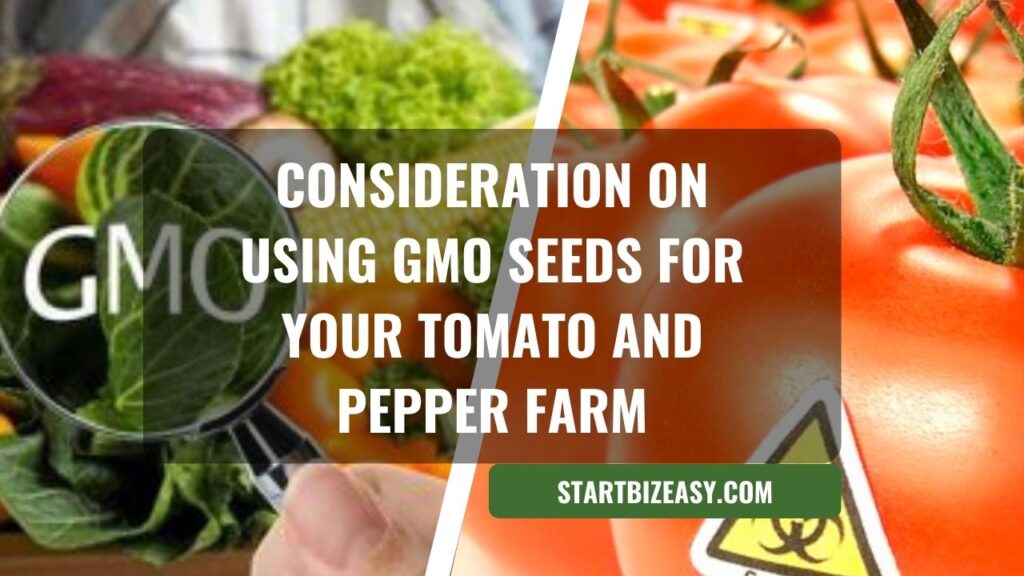
A tomato and pepper farm is an agricultural enterprise focused on the cultivation of two popular vegetable crops: tomatoes and peppers. This type of farm can range in size from small family-owned plots to extensive commercial operations, and it may utilize a variety of farming techniques and technologies to optimize yield and quality.
Tomatoes and peppers are both warm-season crops that thrive in similar environmental conditions, making them well-suited for co-cultivation. These crops require a warm, frost-free growing season, ample sunlight, and well-drained soil rich in organic matter. Farmers often start seeds in controlled environments such as greenhouses to give young plants a strong start before transplanting them to the field.
Tomatoes and peppers are both members of the Solanaceae family, also known as the nightshade family. Within these categories, there are numerous varieties, each with its own unique characteristics and suitability to different climates and soil conditions.
- Tomatoes: There are numerous tomato varieties, including cherry, plum, beefsteak, and heirloom tomatoes. Each variety has specific uses; for instance, cherry tomatoes are often used in salads, while beefsteak tomatoes are preferred for slicing due to their large size.
- Peppers: Peppers also come in various forms, such as bell peppers, hot peppers (like jalapeños and habaneros), and sweet peppers. Each type is selected based on factors such as flavor, color, and heat level, catering to diverse culinary needs.
Tomato and pepper farming involves several stages, from seed selection to harvesting and marketing. Here are the steps to start a tomato and pepper farm on a small or commercial scale:
Table of Contents
Cultivation Practices

The cultivation process can be divided into the following steps:
1. Seed Selection and Germination
When selecting and germinating seeds for your tomato and pepper farm, you need to focus on choosing high-quality seeds that exhibit traits such as disease resistance, high yield potential, and climate adaptability. This careful selection process ensures that the plants will be robust and productive.
Begin by starting your seeds indoors in trays. This controlled environment allows you to manage the germination conditions meticulously. By doing so, you ensure that your seeds have the best possible start, leading to strong and healthy seedlings ready for transplantation.
2. Transplanting:
When your seedlings have reached a suitable height and have developed a robust root system, it is time for you to transplant them to the field. This stage is critical and demands careful handling on your part to avoid damaging the young plants.
Gently remove each seedling from its tray, ensuring you support the root system to prevent breakage. As you place each seedling into its designated spot in the field, make sure to position it at the correct depth to encourage optimal growth. This careful attention to detail during the transplanting process will help ensure the successful establishment and development of your tomato and pepper plants.
3. Soil Preparation:
To prepare your soil for tomato and pepper farming, you must undertake several essential steps to create an ideal growing environment. Begin by plowing the soil to break up any compacted layers and enhance its structure. This process improves soil aeration, allowing roots to penetrate more deeply and access vital nutrients.
Next, you should add organic matter, such as compost or well-rotted manure, to the soil. This addition enriches the soil with nutrients, improves its texture, and increases its water-holding capacity. As you incorporate organic matter, take the time to adjust the soil’s pH levels. Tomatoes and peppers thrive in slightly acidic to neutral soils, with a pH range of 6.0 to 7.0. By testing and amending the pH as necessary, you ensure that the soil provides optimal conditions for nutrient uptake.
Proper drainage and aeration are also crucial. Ensure that your field has a good drainage system to prevent waterlogging, which can lead to root diseases. Similarly, maintaining good soil aeration helps oxygen reach the roots, promoting healthy growth and preventing issues such as root rot.
By diligently preparing your soil through these steps, you create a foundation for a successful and productive tomato and pepper farm.
4. Planting:
When it is time for you to plant your tomatoes and peppers, it is crucial to space the plants appropriately. This careful spacing ensures that each plant has sufficient room for growth and optimal air circulation, both of which are vital for healthy development and preventing disease.
The specific spacing requirements will depend on the variety and growth habits of the plants you have chosen. For example, determinate tomato varieties, which grow to a certain height and then stop, may require less space than indeterminate varieties, which continue to grow and produce fruit throughout the season. Similarly, different types of peppers may have varying space needs based on their size and growth patterns.
As you plant each seedling, make sure to follow the recommended spacing guidelines for the particular variety you are growing. This will help maximize sunlight exposure, reduce competition for nutrients and water, and enhance air circulation around the plants. By paying close attention to these details during the planting process, you set the stage for a bountiful and healthy harvest from your tomato and pepper farm.
5. Irrigation and Fertilization:
In managing your tomato and pepper farm, irrigation and fertilization are crucial aspects that require your careful attention. Consistent watering is vital, particularly during the flowering and fruiting stages, to ensure that your plants have the moisture they need to develop strong roots and produce abundant fruit.
To achieve efficient and effective watering, you might consider using drip irrigation. This method allows you to deliver water directly to the base of each plant, minimizing water wastage and reducing the risk of fungal diseases that can occur with overhead watering. By employing drip irrigation, you ensure that your plants receive a steady and controlled supply of water, promoting healthy growth and maximizing yield.
Fertilization is another critical component that you must tailor to meet the specific nutritional needs of your tomato and pepper plants. Each stage of growth—from seedling to mature fruiting plant—requires different nutrients. For instance, during the early growth stages, a fertilizer high in nitrogen will promote leafy growth, while during the fruiting stage, a fertilizer with higher levels of phosphorus and potassium will support flower and fruit development.
By carefully managing your irrigation and fertilization practices, you ensure that your tomato and pepper plants receive the right amount of water and nutrients at the right times. This attention to detail will lead to robust plant growth, high yields, and a successful farming operation.
6. Pest and Disease Management:
To ensure the health and productivity of your tomato and pepper farm, it is essential that you implement effective pest and disease management strategies. One of the most effective approaches is Integrated Pest Management (IPM), which combines various methods to keep pests and diseases under control while minimizing harm to the environment.
As part of your IPM strategy, you should practice crop rotation. By changing the types of crops you grow in a specific area each season, you disrupt the life cycles of pests and diseases that may be specific to tomatoes and peppers. This reduces the likelihood of these pests and diseases building up to harmful levels in your soil.
You can also introduce natural predators to your farm to help control pest populations. For example, ladybugs and lacewings can be effective against aphids, while nematodes can target root-knot nematodes. By encouraging these beneficial organisms, you create a balanced ecosystem that naturally keeps pest numbers in check.
When necessary, you may need to apply pesticides and fungicides to manage more severe pest and disease outbreaks. It is crucial that you choose products that are effective against the specific pests or diseases you are targeting and use them according to the recommended guidelines. This ensures that you minimize any negative impact on beneficial organisms and the environment.
By employing a comprehensive IPM strategy, you can effectively manage pests and diseases on your farm. This approach helps you maintain healthy plants, maximize your yield, and contribute to sustainable farming practices.
7. Harvesting:
When it comes time for you to harvest your tomatoes and peppers, the timing will vary based on the type of crop and the desired ripeness stage. Understanding these nuances is crucial to ensure that you achieve the best quality and minimize any damage during transport.
For tomatoes, it is often best to pick them when they are firm and slightly under-ripe. This practice helps reduce the risk of bruising and damage during handling and transportation. As the tomatoes continue to ripen off the vine, they will develop their full flavor and color, ready for market or personal use.
Peppers offer more flexibility in harvesting times, depending on the color and ripeness you desire. If you prefer green peppers, you can harvest them when they reach full size but before they start to change color. If you want red, yellow, or other colored peppers, you need to leave them on the plant longer to allow them to mature fully and develop their sweet, rich flavors.
The time frame from planting to harvesting tomatoes and peppers can vary depending on the specific variety and growing conditions. However, I can provide you with a general overview to help you plan your farming schedule.
Tomatoes:
For tomatoes, the time frame from planting to harvesting typically ranges between 60 to 85 days after transplanting the seedlings into the field. Here’s a breakdown of the stages:
- Seed Germination: 5-10 days
- Seedling Stage: 6-8 weeks (before transplanting)
- Growth to Maturity: 50-70 days (after transplanting)
- Harvesting: Begins around 60-85 days post-transplanting, depending on the variety and desired ripeness.
Peppers:
For peppers, the time frame from planting to harvesting generally ranges between 60 to 90 days after transplanting the seedlings into the field. Here’s a similar breakdown:
- Seed Germination: 7-14 days
- Seedling Stage: 8-10 weeks (before transplanting)
- Growth to Maturity: 60-90 days (after transplanting)
- Harvesting: Begins around 60-90 days post-transplanting, depending on the variety and desired color/ripeness.
There are also specific considerations such as:
- Tomatoes: Cherry tomatoes tend to mature faster than larger varieties like beefsteak tomatoes. The maturity period can also be influenced by the specific growing conditions, such as temperature and soil quality.
- Peppers: Bell peppers typically take longer to mature than hot peppers. If you are harvesting green peppers, you can expect to harvest earlier. For red, yellow, or other colored peppers, the harvest time will be closer to the 90-day mark.
By keeping these general time frames in mind and adjusting for the specific varieties you are growing, you can better plan and manage your tomato and pepper farming operations.
This careful approach will help you deliver the best possible produce to your market or kitchen, enhancing your reputation as a diligent and skilled farmer.
Business Practices
To successfully operate a tomato and pepper farm, it is essential that you adopt sound business practices. These practices ensure that your farm runs efficiently, remains profitable, and meets market demands. A well-structured approach encompasses several key components: strategic planning, financial management, marketing, and sustainable practices.
1. Strategic Planning:
Strategic planning is the foundation of your farming business. Begin by setting clear, achievable goals for your farm. These goals might include specific yield targets, expansion plans, or market penetration objectives. Develop a comprehensive business plan that outlines your vision, mission, and the steps needed to achieve your goals. This plan should also include a thorough analysis of market trends, potential risks, and competitive strategies.
2. Financial Management:
Effective financial management is crucial to the sustainability of your farm. You need to maintain accurate records of all expenses and revenues to monitor the financial health of your business. This involves:
- Budgeting: Create detailed budgets that cover all aspects of your operations, from seed purchases and equipment maintenance to labor costs and marketing expenses. Stick to your budget to avoid unnecessary expenditures.
- Cost Control: Implement cost-control measures to minimize waste and maximize efficiency. This can include optimizing resource use, negotiating better prices with suppliers, and investing in energy-efficient technologies.
- Funding: Explore various funding options such as loans, grants, and investment opportunities to support your farm’s growth and development. Ensure that any borrowed funds are used effectively and repayments are managed prudently.
3. Marketing:
A robust marketing strategy is essential to ensure that your tomatoes and peppers reach the right markets at the right time. Your marketing efforts should focus on:
- Market Research: Conduct thorough market research to understand consumer preferences, market trends, and competitive pricing. This information will help you tailor your products to meet market demand and set competitive prices.
- Branding: Develop a strong brand identity that highlights the unique qualities of your produce, such as organic farming practices, heirloom varieties, or local sourcing. A compelling brand can differentiate your products in the marketplace.
- Sales Channels: Diversify your sales channels to reach a broader audience. This can include selling at local farmers’ markets, supplying to grocery stores and restaurants, and utilizing online platforms to reach a wider customer base.
4. Sustainable Practices:
Incorporating sustainable practices into your farming operations not only benefits the environment but can also enhance your farm’s reputation and marketability. Sustainable practices include:
- Resource Management: Implement efficient water and energy use practices, such as drip irrigation and renewable energy sources. These practices reduce costs and minimize environmental impact.
- Soil Health: Maintain soil health through crop rotation, cover cropping, and organic amendments. Healthy soil is the foundation of productive and resilient farming systems.
- Pest Management: Employ integrated pest management (IPM) strategies to reduce reliance on chemical pesticides. This approach promotes a healthier ecosystem and safer working conditions.
5. Compliance and Certification:
Adhering to industry standards and obtaining relevant certifications can enhance your credibility and open new market opportunities. Ensure that your farming practices comply with local, national, and international regulations regarding food safety, labor practices, and environmental protection. Certifications such as organic, fair trade, or non-GMO can add value to your products and attract discerning consumers.
6. Continuous Improvement:
Commit to continuous improvement by staying informed about advancements in agricultural practices and technologies. Participate in agricultural workshops, join farming networks, and collaborate with agricultural extension services. Continuous learning and adaptation are vital to maintaining a competitive edge and achieving long-term success.
How much does it cost to Start Tomato and Pepper Farming Business in Nigeria?
Starting a tomato and pepper farming business in Nigeria involves various costs that depend on the scale of the operation, location, and specific farming practices adopted. Here is a detailed breakdown of the typical costs associated with starting a tomato and pepper farming business in Nigeria.
1. Land Acquisition:
- Purchase or Lease of Land: The cost of land varies widely depending on the location. In rural areas, land is way cheaper compared to urban or peri-urban areas. Using the cost of rural and peri-urban areas:
- Purchase: ₦800,000 to ₦10,000,000 per hectare
- Lease: ₦20,000 to ₦800,000 per hectare per year
2. Land Preparation:
- Clearing and Plowing: Preparation of the land for planting.
- Cost: ₦30,000 to ₦150,000 per hectare
- Soil Testing and Amendments: To determine soil health and necessary amendments.
- Soil Testing: ₦5,000 to ₦10,000 per sample
- Amendments (Lime, Organic Manure): ₦20,000 to ₦150,000 per hectare
3. Seeds and Seedlings:
- High-Quality Seeds: Hybrid seeds resistant to diseases and pests.
- Tomato Seeds: ₦5,000 to ₦10,000 per 100 grams
- Pepper Seeds: ₦4,000 to ₦8,000 per 100 grams
4. Fertilizers and Pesticides:
- Fertilizers: Combination of organic and inorganic fertilizers.
- Cost: ₦40,000 to ₦140,000 per hectare
- Pesticides and Herbicides: For pest and weed control.
- Cost: ₦30,000 to ₦80,000 per hectare
5. Irrigation Systems:
- Drip Irrigation: Preferred for efficient water use.
- Cost: ₦150,000 to ₦300,000 per hectare
6. Labor:
- Planting, Weeding, and Harvesting: Labor costs depend on the intensity of the work and the availability of labor in the area.
- Cost: ₦50,000 to ₦100,000 per hectare per growing season
7. Equipment and Tools:
- Basic Farming Tools: Hoes, cutlasses, sprayers, etc.
- Cost: ₦20,000 to ₦50,000
- Advanced Equipment: Tractors, plows, if needed.
- Cost: ₦2,000,000 to ₦5,000,000 (if not renting)
8. Post-Harvest Handling:
- Storage Facilities: Cold storage or simple storage sheds.
- Cost: ₦100,000 to ₦500,000
- Packaging Materials: For transporting produce to market.
- Cost: ₦20,000 to ₦50,000
9. Miscellaneous Costs:
- Transportation: Moving produce to markets.
- Cost: ₦100,000 to ₦250,000 per season
- Marketing and Sales Expenses: Advertising, market fees.
- Cost: ₦10,000 to ₦30,000
Total Estimated Cost:
Based on the above breakdown, the total cost of starting a tomato and pepper farming business in Nigeria can vary significantly depending on the scale and specific choices made by the farmer. For a small to medium-scale operation, the estimated total cost per hectare might range from:
- Minimum Estimate: ₦800,000
- Maximum Estimate: ₦7,500,000
How Profitable is Tomatoes and Pepper Farming Business?

When you embark on tomato and pepper farming in Nigeria, you are entering a potentially lucrative business with significant opportunities for profit. Both tomatoes and peppers are essential ingredients in Nigerian cuisine, ensuring a constant demand. By understanding the factors that contribute to profitability and effectively managing your operations, you can maximize your returns from this agricultural venture. Factors that contribute to profitability:
1. Market Demand and Pricing:
Tomatoes and peppers are staples in the Nigerian diet, used extensively in various dishes such as soups, stews, and sauces. This widespread use guarantees a steady market for your produce. Prices for these crops can fluctuate based on the season and supply levels. During periods of scarcity, such as the dry season, prices typically rise, offering you the chance to earn higher profits. By strategically timing your planting and harvesting cycles to align with these periods, you can take advantage of favorable market conditions.
2. Yield Potential:
Both tomato and pepper plants have high yield potential when grown under optimal conditions. With the right care, including the use of high-quality seeds, proper fertilization, and effective pest management, you can achieve substantial yields. For example, tomatoes can yield up to 30 tons per hectare which gives you 1,200 baskets of tomatoes, while peppers can produce between 20 to 25 tons per hectare which gives you 200 to 400 baskets of peppers, depending on the variety and growing conditions. These high yields translate directly into increased revenue for your farm.
3. Multiple Harvests:
Tomatoes and peppers have relatively short growing cycles, typically ranging from 60 to 90 days from transplanting to harvesting. This allows you to have multiple planting and harvesting cycles within a single year, each providing an opportunity to generate income. By optimizing your farming schedule, you can ensure a continuous supply of produce, maximizing your overall profitability.
4. Value Addition:
Adding value to your tomatoes and peppers can significantly boost your profits. Processing tomatoes into products like tomato paste, puree, or dried tomatoes and turning peppers into dried pepper flakes or sauces can extend their shelf life and open up new market opportunities. By investing in basic processing equipment, you can cater to both local and international markets, where there is a growing demand for processed agricultural products.
Note: The Nigerian government and various agricultural organizations offer support and grants to farmers. By taking advantage of these opportunities, you can reduce your initial investment costs and access training and resources that can improve your farming practices. This support can enhance your profitability and sustainability in the long term.
Economic and Social Impact
When you cultivate tomatoes and peppers on your farm, you are making a significant contribution to the agricultural economy. These vegetables are staple ingredients in many cuisines around the world, driving high demand in both local and international markets. Your efforts in growing these crops help fulfill this demand, making you an integral part of the global food supply chain.
By operating your tomato and pepper farm, you also provide valuable employment opportunities within your community. From planting and tending to the crops, to harvesting and marketing, your farm creates jobs that support local economies. These jobs help improve the livelihoods of those involved, fostering economic stability and growth in your area.
Your farm also plays a crucial role in enhancing food security. By producing a steady supply of nutritious tomatoes and peppers, you help ensure that people have access to essential vegetables, contributing to a balanced and healthy diet. This is especially important as populations grow and the demand for food increases.
Furthermore, by incorporating sustainable practices on your farm, you contribute to environmental protection and meet the rising consumer demand for healthy, sustainably-produced food. Practices such as organic farming, crop rotation, and the use of renewable resources minimize the environmental impact of your farming activities. These practices help preserve soil health, reduce water usage, and lower greenhouse gas emissions, making your farm more resilient to climate change and other environmental challenges.
When you use sustainable methods, you are not only protecting the environment but also appealing to consumers who prioritize sustainability. This growing market segment values food that is produced responsibly, and by meeting their expectations, you can enhance the reputation and profitability of your farm.
Challenges in Tomato and Pepper Farming
As a tomato and pepper farmer in Nigeria, you face a unique set of challenges that can impact the success and sustainability of your farming operations. Understanding these challenges can help you develop strategies to mitigate their effects and improve your farm’s productivity.
1. Climate and Weather Variability:
In Nigeria, the climate and weather conditions can be highly variable, posing significant challenges for your tomato and pepper crops. Unpredictable rainfall patterns, droughts, and extreme temperatures can stress your plants and reduce yields. To address this, you might consider implementing irrigation systems to ensure a consistent water supply and using shade nets or mulching to protect your crops from extreme heat.
2. Pests and Diseases:
Pests and diseases are major threats to tomato and pepper farming in Nigeria. Common pests such as aphids, whiteflies, and fruit borers, as well as diseases like bacterial wilt and late blight, can devastate your crops. Employing Integrated Pest Management (IPM) strategies, such as crop rotation, biological control, and the judicious use of pesticides, can help you manage these issues effectively.
3. Limited Access to Quality Inputs:
Access to high-quality seeds, fertilizers, and pesticides can be limited in Nigeria, affecting the productivity of your farm. To overcome this challenge, you can establish relationships with reliable suppliers or cooperatives that can provide you with the necessary inputs. Additionally, participating in agricultural extension programs can help you stay informed about the best practices and latest advancements in farming.
4. Infrastructure and Market Access:
Inadequate infrastructure, such as poor road networks and limited storage facilities, can hinder your ability to transport your produce to markets efficiently. This can lead to post-harvest losses and reduced income. To mitigate this, you might explore forming cooperatives with other farmers to pool resources for transportation and storage. Additionally, investing in simple preservation techniques, such as sun drying or processing, can help extend the shelf life of your produce.
5. Financial Constraints:
Securing adequate financing for your farming activities can be challenging. Limited access to credit and high-interest rates can restrict your ability to invest in necessary inputs and technologies. To address this, you can seek out microfinance institutions, government grants, and agricultural development programs that offer financial support to farmers. Additionally, maintaining accurate financial records and developing a solid business plan can enhance your credibility with potential lenders.
6. Knowledge and Skill Gaps:
Keeping up with the latest farming techniques and best practices is essential for maximizing your yields and maintaining soil health. However, knowledge and skill gaps can be a barrier. To overcome this, you should take advantage of training programs and workshops offered by agricultural extension services, NGOs, and other organizations. Engaging with farming communities and networks can also facilitate the exchange of knowledge and experiences.
7. Policy and Regulatory Issues:
Navigating the policy and regulatory environment can be complex and challenging. Inconsistent policies, lack of government support, and bureaucratic hurdles can affect your farming operations. Staying informed about relevant regulations and advocating for farmer-friendly policies through local associations can help you address these challenges.
By understanding and proactively addressing these challenges, you can enhance the resilience and productivity of your tomato and pepper farm in Nigeria. Your dedication and strategic approach will contribute to a more sustainable and successful farming operation.
Consideration on using GMO Seeds for your Tomato and Pepper Farm

When deciding whether to use GMO (genetically modified organism) seeds for your tomato and pepper farm, it is important to consider various factors, including potential benefits and drawbacks. Here are some key points to help you make an informed decision:
Advantages of Using GMO Seeds
- Enhanced Resistance to Pests and Diseases: GMO seeds are often engineered to be resistant to specific pests and diseases. This can reduce the need for chemical pesticides, leading to lower production costs and a reduced environmental impact.
- Higher Yields: GMO seeds can be designed to produce higher yields compared to non-GMO varieties. This can be particularly beneficial in maximizing productivity and profitability on your farm.
- Drought and Stress Tolerance: Some GMO seeds are engineered to tolerate drought and other environmental stresses better than conventional seeds. This can be advantageous in regions with variable climate conditions.
- Nutritional Enhancement: GMO crops can be modified to have enhanced nutritional content, which can be beneficial for consumers and can provide a marketing advantage.
Disadvantages of Using GMO Seeds
- Cost: GMO seeds are often more expensive than conventional seeds. The initial investment may be higher, which could be a concern if you have limited financial resources.
- Market Acceptance: There can be consumer resistance to GMO products due to health and environmental concerns. Some markets, both local and international, prefer non-GMO produce, which could limit your sales opportunities.
- Environmental Impact: There are concerns about the long-term environmental impact of GMO crops, including potential effects on biodiversity and the development of resistant pests and weeds.
- Regulatory and Ethical Issues: The use of GMO seeds may be subject to regulatory restrictions. Additionally, there are ethical considerations regarding the use of genetic modification in agriculture that you may need to consider.
The decision to use GMO seeds for your tomato and pepper farm should be based on a careful assessment of these factors. If the potential benefits, such as increased yields and resistance to pests and diseases, outweigh the costs and potential market limitations, GMO seeds could be a valuable tool for improving the productivity and sustainability of your farm.
However, it is also essential to stay informed about consumer preferences and regulatory requirements in your target markets. By weighing the advantages and disadvantages, you can make a decision that aligns with your farming goals and market strategy.
Ultimately, your choice will depend on your specific circumstances, including your financial capacity, market demands, and ethical considerations. Consulting with agricultural experts and conducting thorough research will further assist you in making the best decision for your farm.
Read Also:
- 16 Lucrative Staple Food Business Ideas in Nigeria
- How to Start Food Processing Business: The All-in-One Guide
- Rice Business in Nigeria Made Easy: A Success Guide
- How to Start Fruit and Vegetable Farming Business: Your Complete Step-By-Step Guide
- How to Start a Fruit and Vegetable Business as a Seller: Your Step-by-Step Guide





